Damage Mechanism Based Approach to the Structural Health Monitoring of Wind Turbine Blades
Abstract
1. Introduction
2. Maintenance and Health Monitoring of WT Blades: State of the Art
2.1. Value of Information and Modeling in Maintenance Analysis
2.2. Vibration-Based Techniques/Operation Modal Analysis
2.3. Acoustic Emissions (AEs)
2.4. Strain Measurement
2.5. Ultrasound Wave Propagation
2.6. Measuring Impedance Changes
2.7. Thermography and Imaging
2.8. Embedded Conductive Nanoscale Particles
2.9. Damage Detection
2.10. Limitations and Challenges
3. Concept of Mechanism Based Structural Health Monitoring of Wind Turbine Blades
3.1. On the Damage Mechanism-Informed Health Monitoring
3.2. Degradation Mechanisms of Wind Turbine Blades
4. Demonstration: Monitoring Specific Damage Mechanisms
4.1. Leading Edge Erosion by a Single Point Impact Fatigue Test (SPIFT)
4.2. Interface Crack Opening and Interface Crack Progression
4.3. Plydrop Delamination Propagation Rate during Tensile Testing
4.4. Root Bolt Failure
4.5. Bulk Material Fatigue
5. Future Directions
6. Conclusions
Author Contributions
Funding
Conflicts of Interest
References
- Wind Energy in Europe: Outlook to 2023. October 2019. Available online: https://www.anev.org/wp-content/uploads/2019/10/Market-outlook-2019.pdf (accessed on 10 December 2020).
- Operation and Maintenance Costs of Wind Generated Power. Available online: https://www.wind-energy-the-facts.org (accessed on 10 December 2020).
- Stephenson, S. Wind Blade Repair: Planning, Safety, Flexibility. Composites World, 2011. Available online: https://www.compositesworld.com/columns/wind-blade-repair-planning-safety-flexibility(2) (accessed on 14 December 2020).
- Karavida, S.; Nõmmik, R. Waste Management of End-of-Service Wind Turbines. Master’s Thesis, Aalborg University, Aalborg, Denmark, June 2015. Available online: https://projekter.aau.dk/projekter/files/213319772/Waste_management_of_end_of_service_wind_turbines.pdf (accessed on 14 December 2020).
- Ruhul, A.; Peter, M.; Michael, P. Condition Based Maintenance: A UK pilot study. Int. J. Facil. Manag. 2015, 6. [Google Scholar]
- Starr, A.; Al-Najjar, B.; Holmberg, K.; Jantunen, E.; Bellew, J.; Albarbar, A. Maintenance Today and Future Trends, E-Maintenance; Springer: London, UK, 2010. [Google Scholar]
- Gerdes, M. Effects of Effects of Condition-Based Maintenace on Costs Caused by Unscheduled Maintenance of Aircraft. 2016. Available online: https://www.fzt.haw-hamburg.de/pers/Scholz/PAHMIR/GERDES-2016_Condition-basedMaintenanceOnCosts_JQME.pdf (accessed on 10 December 2020).
- Lasch, R.; Fritzsche, R. Logistics Management; Springer: Berlin/Heidelberg, Germany, 2016. [Google Scholar]
- Rumsey, M.A.; Paquette, J.A. Structural Health Monitoring of Wind Turbine Blades* Proceedings Volume 6933, Smart Sensor Phenomena, Technology, Networks, and Systems 2008; 69330E. Available online: https://doi.org/10.1117/12.778324 (accessed on 10 December 2020).
- Lian, J.; Cai, O.; Dong, X.; Jiang, Q.; Zhao, Y. Health Monitoring and Safety Evaluation of the Offshore Wind Turbine Structure: A Review and Discussion of Future Development. Sustainability 2019, 11, 494. [Google Scholar] [CrossRef]
- Yang, B.; Sun, D. Testing inspecting and monitoring technologies for wind turbine blades: A survey. Renew. Sustain. Energy Rev. 2013, 22, 515–526. [Google Scholar]
- Hyers, R.W.; Mcgowan, J.G.; Sullivan, K.L.; Manwell, J.F.; Syrett, B.C. Condition monitoring and prognosis of utility scale wind turbines. Adv. Energy Mater. 2006, 1, 187–203. [Google Scholar] [CrossRef]
- Antoniadou, I.; Dervilis, N.; Papatheou, E.; Maguire, A.E.; Worden, K. Aspects of structural health and condition monitoring of offshore wind turbines. Philos. Trans. A Math Phys. Eng. Sci. 2015, 373, 20140075. [Google Scholar] [CrossRef] [PubMed]
- Amenabar, I.; Mendikute, A.; López-Arraiza, A.; Lizaranzu, A.; Aurrekoetxea, J. Comparison and analysis of non-destructive testing techniques suitable for delamination inspection in wind turbine blades. Compos. Part B Eng. 2011, 42, 1298–1305. [Google Scholar] [CrossRef]
- Yang, W.; Peng, Z.; Wei, K.; Tian, W. Structural health monitoring of composite wind turbine blades: Challenges, issues and potential solutions. IET Renew. Power Gener. 2017, 11, 411–416. [Google Scholar] [CrossRef]
- Martinez-Luengo, M.; Kolios, A.; Wang, L. Structural health monitoring of offshore wind turbines: A review through the Statistical Pattern Recognition Paradigm. Renew. Sustain. Energy Rev. 2016, 64, 91–105. [Google Scholar] [CrossRef]
- Wang, K.S.; Sharma, V.S.; Zhang, Z.Y. SCADA data based condition monitoring of wind turbines. Adv. Manuf. 2014, 2, 61–69. [Google Scholar] [CrossRef]
- Fischer, K.; Coronado, D. Condition monitoring of wind turbines: State of the art, user experience and recommendations. VGB PowerTech. 2015, 7, 51–56. [Google Scholar]
- Joshuva, A.; ASLESH, A.K.; Sugumaran, V. State of the art of structural health monitoring of wind turbines. Int. J. Mech. Sci. 2019. [Google Scholar] [CrossRef]
- Ou, Y.; Chatzi, E.N.; Dertimanis, V.K.; Spiridonakos, M.D. Vibration-based experimental damage detection of a small-scale wind turbine blade. Struct. Health Monit. 2017, 16, 79–96. [Google Scholar] [CrossRef]
- Dervilis, N.; Choi, M.; Taylor, S.G.; Barthorpe, R.J.; Park, G.; Farrar, C.R.; Worden, K. On damage diagnosis for a wind turbine blade using pattern recognition. J. Sound Vib. 2014, 333, 1833–1850. [Google Scholar] [CrossRef]
- Sutherland, H.; Beattie, A.; Hansche, B.; Musial, W.; Allread, J.; Johnson, J.; Summers, M. The Application of Nondestructive Techniques to the Testing of a Wind Turbine Blade; Nasa Sti/recon Technical Report N; Sandia National Laboratories: Livermore, CA, USA, 1994.
- Kirikera, G.R.; Shinde, V.; Schulz, M.J.; Sundaresan, M.J.; Hughes, S.; Dam, J.V.; Nkrumah, F.; Grandhi, G.; Ghoshal, A. Monitoring Multi-Site Damage Growth During Quasi-Static Testing of a Wind Turbine Blade using a Structural Neural System. Struct. Health Monit. 2008, 7, 157–173. [Google Scholar] [CrossRef]
- SAE Standard. Guidelines for Implementation of Structural Health Monitoring on Fixed Wing Aircraft ARP6461; Society of Automotive Engineers: Warrendale, PA, USA, 2013. [Google Scholar]
- Straub, D.; Chatzi, E.; Bismut, E.; Courage, W.M.G.; Döhler, M.; Faber, M.H.; Zonta, D. Value of information: A roadmap to quantifying the benefit of structural health monitoring. In Safety, Reliability, Risk, Resilience and Sustainability of Structures and Infrastructure; Bucher, C., Ellingwood, B., Frangopol, D., Eds.; TU Verlag: Vienna, Austria, 2017; pp. 3018–3029. [Google Scholar]
- Ossai, C.I.; Boswell, B.; Davies, I.J. A Markovian approach for modelling the effects of maintenance on downtime and failure risk of wind turbine components. Renew. Energy 2016, 96, 775–783. [Google Scholar] [CrossRef]
- Bangalore, P.; Patriksson, M. Analysis of SCADA data for early fault detection, with application to the maintenance management of wind turbines. Renew. Energy 2018, 115, 521–532. [Google Scholar] [CrossRef]
- Nielsen, J.J.; Tcherniak, D.; Ulriksen, M.D. A case study on risk-based maintenance of wind turbine blades with structural health monitoring. Struct. Infrastruct. Eng. 2020, 1–17. [Google Scholar] [CrossRef]
- Arsenaul, T.J.; Achuthan, A.; Marzocca, P.; Grappasonni, C.; Coppotelli, G. Development of a FBG based distributed strain sensor system for wind turbine structural health monitoring. Smart Mater. Struct. 2013, 22. [Google Scholar] [CrossRef]
- Ghoshal, A.; Sundaresan, M.J.; Schulz, M.J.; Pai, P.F. Structural health monitoring techniques for wind turbine blades. J. Wind. Eng. Ind. Aerodyn. 2000, 85, 309–324. [Google Scholar] [CrossRef]
- Kim, H.C.; Kim, M.-H.; Choe, D.-E. Structural health monitoring of towers and blades for floating offshore wind turbines using operational modal analysis and modal properties with numerical-sensor signals. Ocean Eng. 2019, 188. [Google Scholar] [CrossRef]
- Tcherniak, D.; Mølgaard, L.L. Active vibration-based structural health monitoring system for wind turbine blade: Demonstration on an operating Vestas V27 wind turbine. Struct. Health Monit. 2017, 16, 536–550. [Google Scholar] [CrossRef]
- Niezrecki, C.; Inalpolat, M. Structural Health Monitoring of Wind Turbine Blades Using Wireless Acoustic Sensing, 2015, Patent. Available online: https://patents.google.com/patent/WO2015065873A3/ (accessed on 10 December 2020).
- Poozesh, P.; Aizawa, K.; Niezrecki, C.; Baqersad, J.; Inalpolat, M.; Heilmann, G. Structural health monitoring of wind turbine blades using acoustic microphone array. Struct. Health Monit. 2016, 16, 471–485. [Google Scholar] [CrossRef]
- Traylor, C.; DiPaola, M.; Willis, D.J.; Inalpolat, M. A computational investigation of airfoil aeroacoustics for structural health monitoring of wind turbine blades. Wind Energy 2019, 23, 795–809. [Google Scholar] [CrossRef]
- Papasalouros, D.; Tsopelas, N.; Anastasopoulos, A.; Kourousis, D.; Lekou, D.J.; Mouzakis, F. Acoustic emission monitoring of composite blade of NM48/750 NEG-MICON wind turbine. J. Acoust. Emiss. 2013, 31, 36–49. [Google Scholar]
- Song, G.; Li, H.; Gajic, B.; Zhou, W.; Chen, P.; Gu, H. Wind turbine blade health monitoring with piezoceramic-based wireless sensor network. Int. J. Smart Nano Mater. 2013, 4, 150–166. [Google Scholar] [CrossRef]
- Zhang, F.; Li, Y.; Yang, Z.; Zhang, L. Investigation of wind turbine blade monitoring based on optical fiber Brillouin sensor. In Proceedings of the 2009 International Conference on Sustainable Power Generation and Supply, Nanjing, China, 6–7 April 2009; pp. 1–4. [Google Scholar]
- Schroeder, K.; Ecke, W.; Apitz, J.; Lembke, E.; Lenschow, G. A Fibre Bragg grating sensor system monitors operational load in a wind turbine rotor blade. Meas. Sci. Technol. 2006, 17, 1167–1172. [Google Scholar] [CrossRef]
- Lee, J.R.; Shin, H.J.; Chia, C.C.; Dhital, D.; Yoon, D.J.; Huh, Y.H. Long distance laser ultrasonic propagation imaging system for damage visualization. Opt. Lasers Eng. 2011, 49, 1361–1371. [Google Scholar] [CrossRef]
- Park, B.; Sohn, H.; Yeum, C.M.; Truong, T.C. Laser ultrasonic imaging and damage detection for a rotating structure. Struct. Health Monit. 2013, 12, 494–506. [Google Scholar] [CrossRef]
- Arnold, P.; Moll, J.; Mälzer, M.; Krozer, V.; Pozdniakov, D.; Salman, R.; Rediske, S.; Scholz, M.; Friedmann, H.; Nuber, A. Radar-based structural health monitoring of wind turbine blades: The case of damage localization. Wind Energy 2018. [Google Scholar] [CrossRef]
- Park, G.; Inman, D.J. Structural health monitoring using piezoelectric impedance measurements. Phil. Trans. R. Soc. A 2007, 365, 373–392. [Google Scholar] [CrossRef]
- Pitchford, C.; Grisso, B.L.; Inman, D.J. Impedance-based structural health monitoring of wind turbine blades. In Proceedings of the SPIE 6532, Health Monitoring of Structural and Biological Systems 2007, 65321I, San Diego, CA, USA, 11 April 2007. [Google Scholar] [CrossRef]
- Hwang, S.; An, Y.K.; Sohn, H. Continuous Line Laser Thermography for Damage Imaging of Rotating Wind Turbine Blades. Procedia Eng. 2016, 188, 225–232. [Google Scholar] [CrossRef]
- Fiedler, B.; Gojny, F.H.; Wichmann, M.H.; Bauhofer, W.; Schulte, K. Can carbon nanotubes be used to sense damage in composites? Ann. Chim. Sci. Mat. 2004, 29, 81–94. [Google Scholar] [CrossRef]
- Thostenson, E.T.; Chou, T. Real-time in situ sensing of damage evolution in advanced fiber composites using carbon nanotube networks. Nanotechnology 2008, 19, 215713. [Google Scholar] [CrossRef] [PubMed]
- Thostenson, E.T.; Chou, T. Carbon nanotube networks: Sensing of distributed strain and damage for life prediction and self healing. Adv. Mater. 2006, 18, 2837–2841. [Google Scholar] [CrossRef]
- Hu, N.; Fukunaga, H.; Atobe, S.; Liu, Y.; Li, J. Piezoresistive strain sensors made from carbon nanotubes based polymer nanocomposites. Sensors 2011, 11, 10691–10723. [Google Scholar]
- Kang, I.; Schulz, M.; Kim, J.H.; Shanov, V.; Shi, D. A carbon nanotube strain sensor for structural health monitoring. Smart Mater. Struct. 2006, 15, 737–748. [Google Scholar] [CrossRef]
- Sam-Daliri, O.; Faller, L.M.; Farahani, M.; Roshanghias, A.; Oberlercher, H.; Mitterer, T.; Araee, A.; Zangl, H. MWCNT–Epoxy Nanocomposite Sensors for Structural Health Monitoring. Electronics 2018, 7, 143. [Google Scholar] [CrossRef]
- Dai, H. An Innovative Sensing Approach Using Carbon Nanotube-Based Composites for Structural Health Monitoring of Concrete Structures. Ph.D. Thesis, University of Delaware, Newark, DE, USA, 2017. [Google Scholar]
- Grabowski, K.; Zbyrad, P.; Uhl, T.; Staszewski, W.J.; Packo, P. Multiscale electro-mechanical modeling of carbon nanotube composites. Comput. Mater. Sci. 2017, 135, 169–180. [Google Scholar] [CrossRef]
- Grabowski, K.; Zbyrad, P.; Wilmański, A.; Uhl, T. Strain sensors based on carbon nanotube—Polymer coatings. In Proceedings of the EWSHM—7th European Workshop on Structural Health Monitoring, IFFSTTAR, Inria, Université de Nantes, Nantes, France, 27 July 2014. [Google Scholar]
- Li, Y.; Liao, Y.; Su, Z. Graphene-functionalized polymer composites for self-sensing of ultrasonic waves: An initiative towards “sensor-free” structural health monitoring. Compos. Sci. Technol. 2018, 168, 203–213. [Google Scholar] [CrossRef]
- Carroll, J.; McDonald, A.; McMillan, D. Failure rate, repair time and unscheduled O&M cost analysis of offshore wind turbines. Wind. Energy 2016, 19, 1107–1119. [Google Scholar] [CrossRef]
- Caithness Windfarm Information Forum, Accident Statistics. 2013. Available online: http://www.caithnesswindfarms.co.uk/ (accessed on 11 December 2020).
- Branner, K.; Ghadirian, A. Database about Blade Faults; DTU Wind Energy E, No. 0067; DTU Wind Energy: Roskilde, Denmark, 2014. [Google Scholar]
- Tavner, P. How are we going to make offshore wind farms more reliable? In SUPERGEN Wind 2011 General Assembly; 20 March 2011; Durham University: Durham, UK, 2011; Available online: https://docplayer.net/37070508-Supergen-wind-2011-general-assembly-how-are-we-going-to-make-offshore-wind-farms-more-reliable-peter-tavner-20-th-march-2011-durham-university.html (accessed on 11 December 2020).
- Lu, B.; Li, Y.; Wu, X.; Yang, Z. A review of recent advances in wind turbine condition monitoring and fault diagnosis. In Proceedings of the Power Electronics and Machines in Wind Applications, Lincoln, NE, USA, 24–26 June 2009; pp. 1–7. [Google Scholar]
- Mishnaevsky, L., Jr. Repair of wind turbine blades: Review of methods and related computational mechanics problems. Renew. Energy 2019, 140, 828–839. [Google Scholar] [CrossRef]
- Mischnaewski, L., III; Mishnaevsky, L., Jr. Structural repair of wind turbine blades: Computational model for the evaluation of the effects of adhesive and patch properties on the repair quality. Wind Energy 2020. [Google Scholar] [CrossRef]
- Shohag, M.A.S.; Hammel, E.C.; Olawale, D.O.; Okoli, O.I. Damage mitigation techniques in wind turbine blades: A review. Wind Eng. 2017, 41, 185–210. [Google Scholar] [CrossRef]
- Khan, M.M.; Iqbal, M.T.; Khan, F. Reliability and condition monitoring of a wind turbine. In Proceedings of the 18th Annual Canadian Conference Electrical and Computer Engineering, Saskatchewan, ON, Canada, 1–4 May 2005; pp. 1978–1981. [Google Scholar]
- Mishnaevsky, L., Jr.; Thomsen, K. Costs of repair of wind turbine blades: Influence of technology aspects. Wind Energy 2020. [Google Scholar] [CrossRef]
- Ciang, C.C.; Lee, J.R.; Bang, H.J. Structural health monitoring for a wind turbine system: A review of damage detection methods. Meas. Sci. Technol. 2008, 19, 122001. [Google Scholar] [CrossRef]
- Li, D.; Ho, S.C.M.; Song, G.; Ren, L.; Li, H. A review of damage detection methods for wind turbine blades. Smart. Mater. Struct. 2015, 24, 1–24. [Google Scholar]
- Chen, X. Fracture of wind turbine blades in operation—Part I: A comprehensive forensic investigation. Wind Energy 2018. [Google Scholar] [CrossRef]
- Sørensen, B.F.; Lading, L.; Sendrup, P.; McGugan, M.; Debel, C.P.; Kristensen, O.J.D.; Larsen, G.C.; Hansen, A.M.; Rheinländer, J.; Rusborg, J.; et al. Fundamentals for Remote Structural Health Monitoring of Wind Turbine Blades—A Preproject; Risoe-R; No. 1336EN; Forskningscenter Risoe: Roskilde, Denmark, 2002; p. 36. [Google Scholar]
- Mishnaevsky, L., Jr.; Branner, K.; Petersen, H.N.; Beauson, J.; McGugan, M.; Sørensen, B. Materials for wind turbine blades: An overview. Materials 2017, 10, 1285. [Google Scholar] [CrossRef]
- Mishnaevsky, L., Jr. Toolbox for optimizing anti-erosion protective coatings of wind turbine blades: Overview of mechanisms and technical solutions. Wind Energy 2019, 22, 1–18. [Google Scholar] [CrossRef]
- Mishnaevsky, L., Jr.; Fæster, S.; Mikkelsen, L.P.; Kusano, Y.; Bech, J.I. Micromechanisms of leading edge erosion of wind turbine blades: X-Ray tomography analysis and computational studies. Wind Energy 2019, 1–16. [Google Scholar] [CrossRef]
- Fredianelli, L.; Carpita, S.; Licitra, G. A procedure for deriving wind turbine noise limits by taking into account annoyance. Sci. Total. Environ. 2019, 648, 728–736. [Google Scholar] [CrossRef] [PubMed]
- Pohl, J.; Gabriel, J.; Hübner, G. Understanding stress effects of wind turbine noise–The integrated approach. Energy Policy 2018, 112, 119–128. [Google Scholar] [CrossRef]
- Liu, W.Y. A review on wind turbine noise mechanism and de-noising techniques. Renew. Energy 2017, 108, 311–320. [Google Scholar] [CrossRef]
- Mishnaevsky, L., Jr.; Brøndsted, P. Statistical modelling of compression and fatigue damage of unidirectional fiber reinforced composites. Compos. Sci. Technol. 2009, 69, 477–484. [Google Scholar] [CrossRef]
- Bech, J.; Hasager, C.B.; Bak, C. Extending the life of wind turbine blade leading edges by reducing the tip speed during extreme precipitation events. Wind Energy Sci. 2018, 3, 729–748. [Google Scholar] [CrossRef]
- Fraisse, A.; Bech, J.I.; Borum, K.K.; Fedorov, V.; Johansen, N.F.-J.; McGugan, M.; Mishnaevsky, L., Jr.; Kusano, Y. Impact fatigue damage of coated glass fibre reinforced polymer laminate. Renew. Energy 2018, 126, 1102–1112. [Google Scholar] [CrossRef]
- McGugan, M.; Pereira, G.; Sørensen, B.F.; Toftegaard, H.; Branner, K. Damage tolerance and structural monitoring for wind turbine blades. Phil. Trans. R. Soc. A 2015, 373, 20140077. [Google Scholar] [CrossRef]
- Torres-Arredondo, M.A.; Tibaduiza, D.-A.; McGugan, M.; Toftegaard, H.L.; Borum, K.K.; Mujica, L.E.; Rodellar, J.; Fritzen, C.-P. Multivariate data-driven modelling and pattern recognition for damage detection and identification for acoustic emission and acousto-ultrasonics. Smart Mater. Struct. 2013, 22, 105023. [Google Scholar] [CrossRef]
- Khan, B.; Potter, K.; Wisnom, M.R. Suppression of delamination at ply drops in tapered composites by ply chamfering. J. Compos. Mater. 2006, 40, 157–174. [Google Scholar] [CrossRef]
- Goutianos, S.; Sørensen, B.F. An element test specimen with ply drops to study fatigue crack growth rates at geometry transitions. In Proceedings of the 9th International Conference on Composites Testing and Model Identification, Luleå, Sweden, 29 May 2019. [Google Scholar]
- Boncel, S.; Kolanowska, A.; Kuziel, A.W.; Krzyżewska, I. Carbon Nanotube Wind Turbine Blades: How Far Are We Today from Laboratory Tests to Industrial Implementation? ACS Appl. Nano Mater. 2018, 1, 6542–6555. [Google Scholar] [CrossRef]
- Yavari, F.; Rafiee, M.A.; Rafiee, J.; Yu, Z.-Z.; Koratkar, N. Dramatic Increase in Fatigue Life in Hierarchical Graphene Composites. ACS Appl. Mater. Interfaces 2010, 2, 2738–2743. [Google Scholar] [CrossRef] [PubMed]
- Dai, G.M.; Mishnaevsky, L., Jr. Carbone nanotube reinforced hybrid composites: Computational modelling of environmental fatigue and usability for wind blades. Compos. Part B Eng. 2015, 78, 349–360. [Google Scholar] [CrossRef]
- Zhou, H.W.; Yi, H.Y.; Liu, Y.Q.; Hu, X.; Warrier, A.; Dai, G.M.; Mishnaevsky, L., Jr. Carbon fiber/carbon nanotube based hierarchical composites: Effect of CNT distribution on shearing strength. Compos. B 2016, 88, 201–211. [Google Scholar] [CrossRef]
- Boehle, M.; Jiang, Q.; Li, L.; Lagounov, A.; Lafdi, K. Carbon nanotubes grown on glass fiber as a strain sensor for real time structural health monitoring. Int. J. Smart Nano Mater. 2012, 3, 162–168. [Google Scholar] [CrossRef][Green Version]
- Turkenburg, D.H.; Van Bracht, H.; Funke, B.; Schmider, M.; Janke, D.; Fischer, H.R. Polyurethane adhesives containing Diels–Alder-based thermoreversible bonds. J. Appl. Polym. Sci. 2017. [Google Scholar] [CrossRef]
- Cohades, A.; Branfoot, C.; Rae, S.; Bond, I.; Michaud, V. Progress in Self-Healing Fiber Reinforced Polymer Composites. Adv. Mater. Interfaces 2018, 5. [Google Scholar] [CrossRef]
- Matt, A.; Strong, S.; Elgammal, T.; Amano, R.S. Development of Novel Self-Healing Polymer Composites for Use in Wind Turbine Blades. J. Energy Resour. Technol. 2015. [Google Scholar] [CrossRef]
- Yang, X.; Guo, L.; Xu, X.; Shang, S.; Liu, H. A fully bio-based epoxy vitrimer: Self-healing, triple-shape memory and reprocessing triggered by dynamic covalent bond exchange. Mater. Des. 2020, 186, 108248. [Google Scholar] [CrossRef]
- Azcune, I.; Odriozola, I. Aromatic disulfide crosslinks in polymer systems: Self-healing, reprocessability, recyclability and more. Eur. Polym. J. 2016, 84, 147–160. [Google Scholar] [CrossRef]
- Jiménez, A.A.; Muñoz, C.Q.G.; Márquez, F.P.G. Machine Learning for Wind Turbine Blades Maintenance Management. Energies 2018, 11, 13. [Google Scholar] [CrossRef]
- Mishnaevsky, L., Jr. Nanostructured interfaces for enhancing mechanical properties of materials: Computational micromechanical studies. Compos. Part B 2015, 68, 75–84. [Google Scholar] [CrossRef]

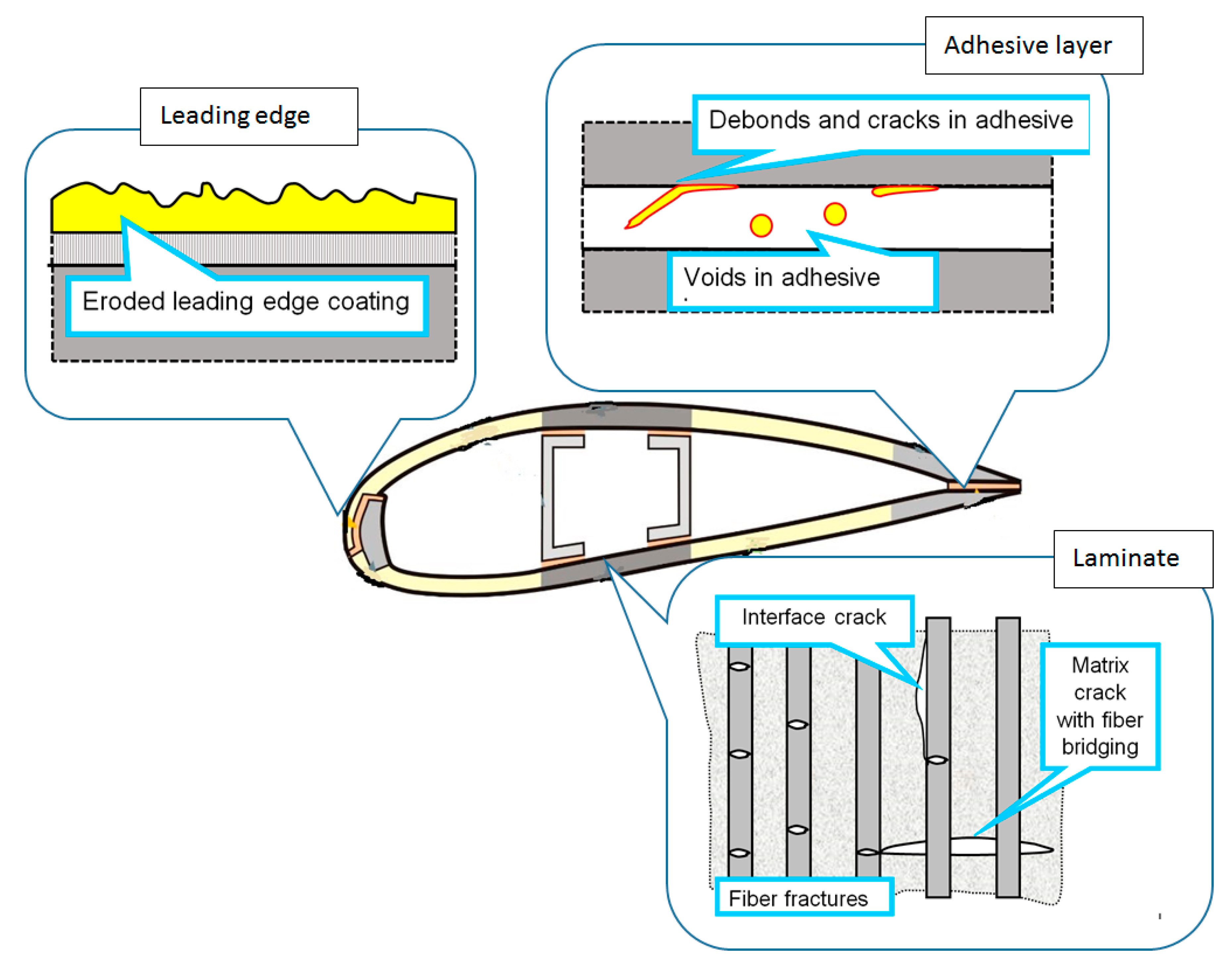
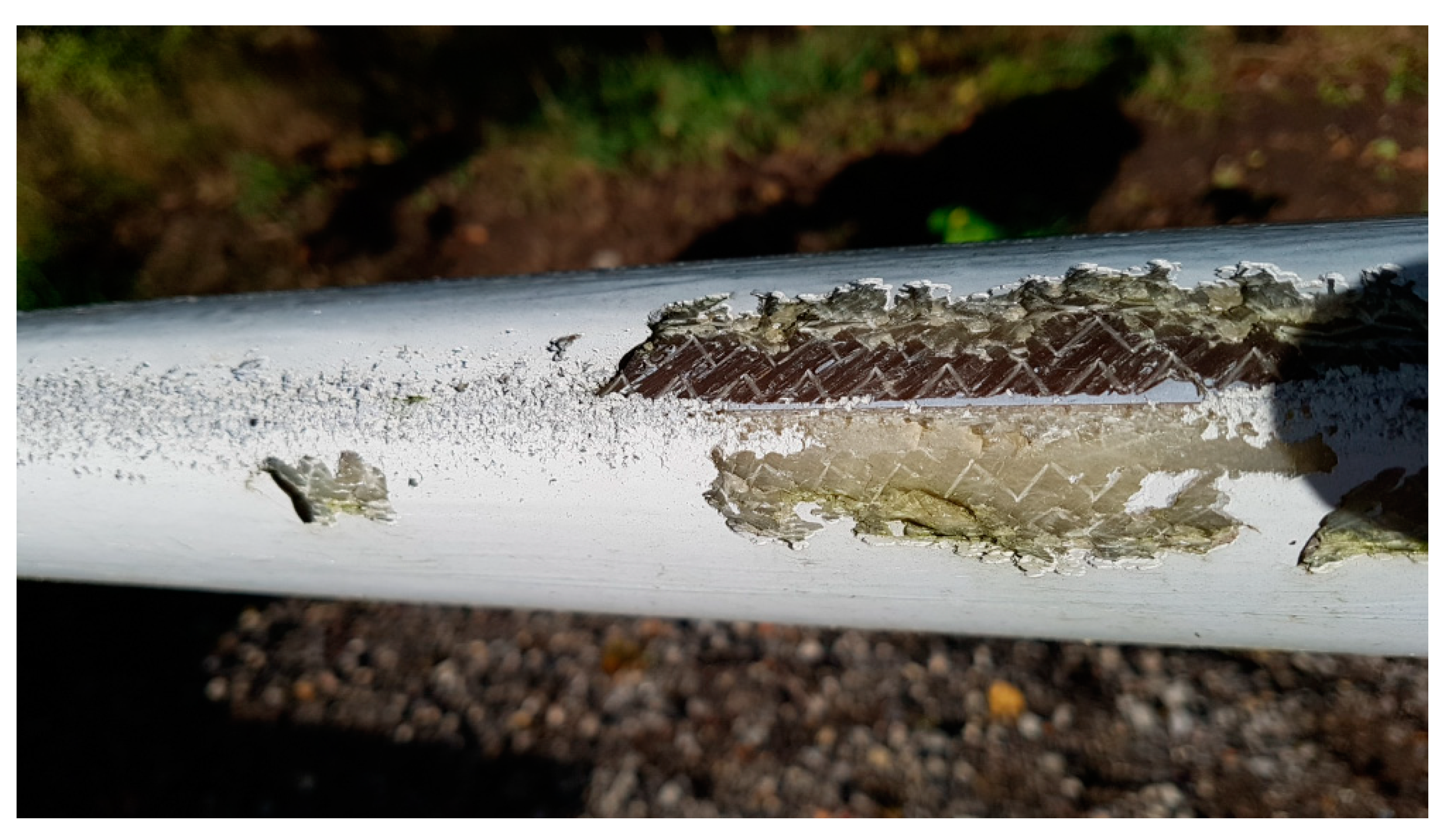
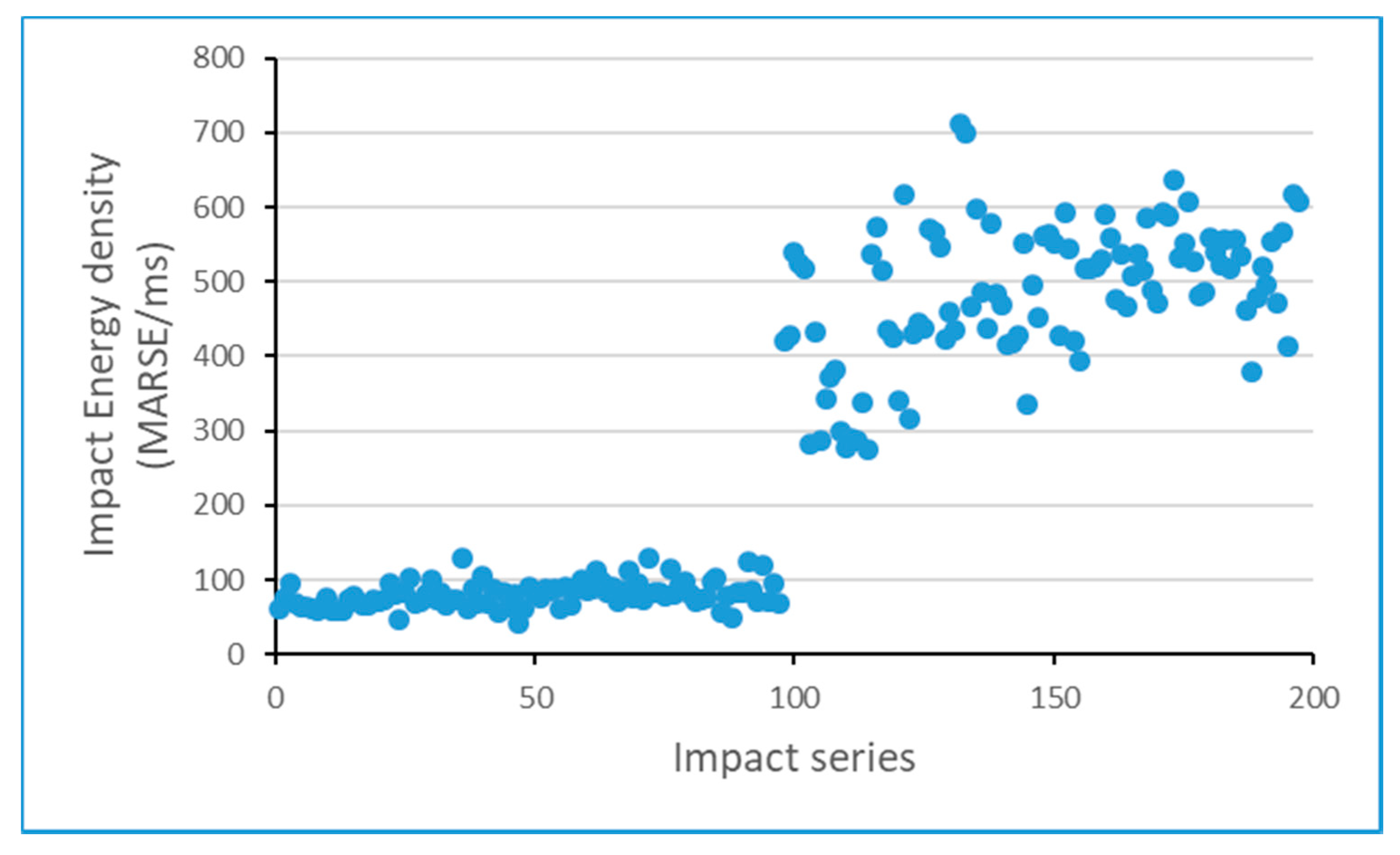

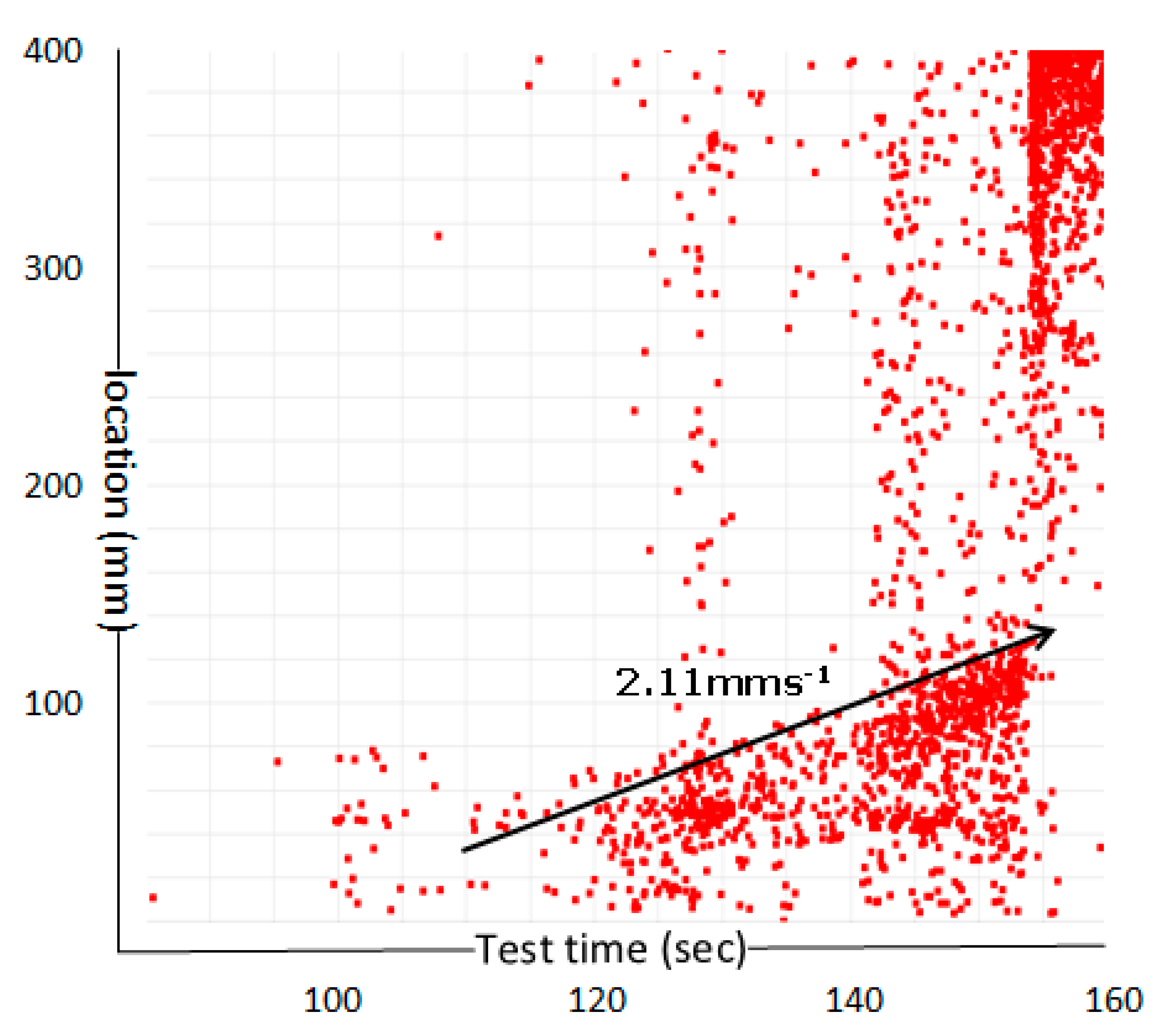


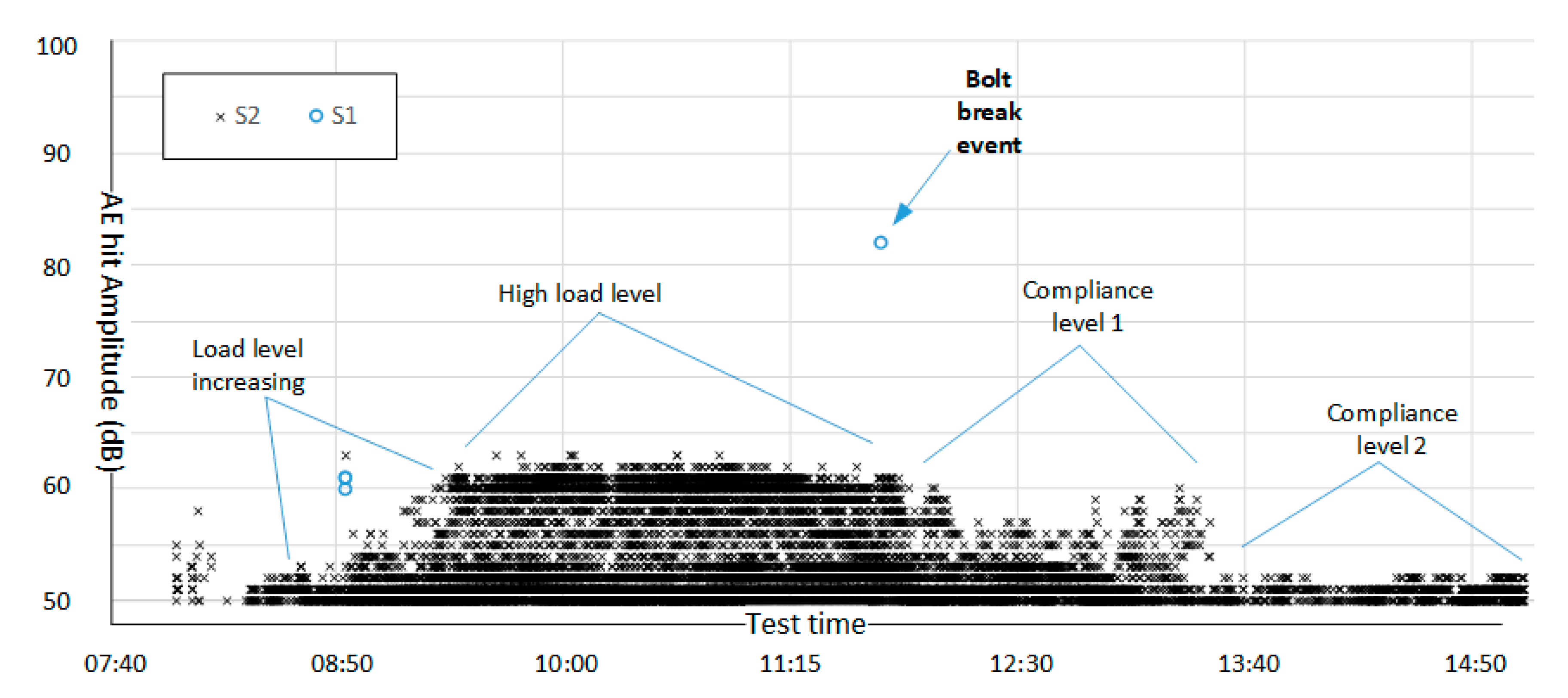

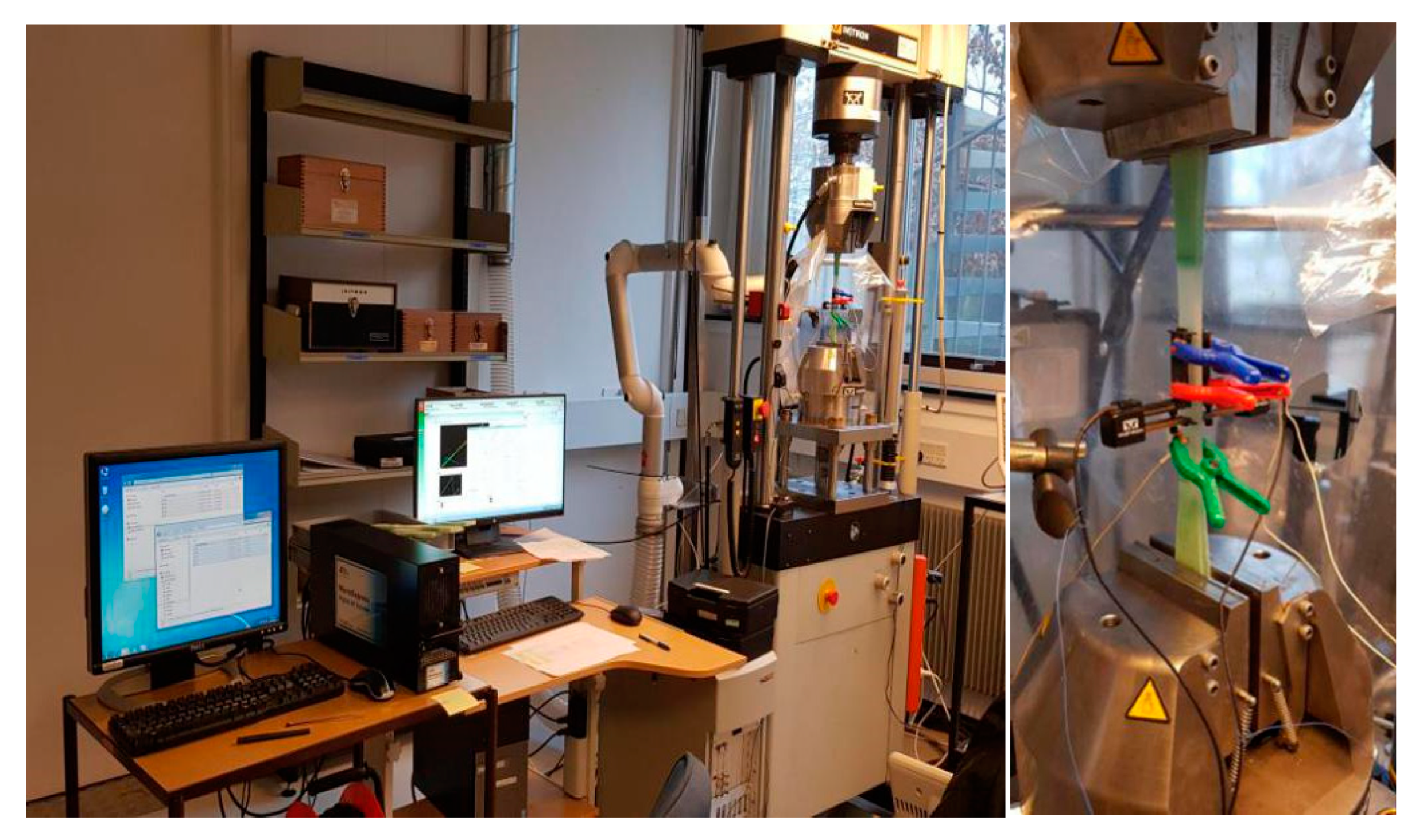

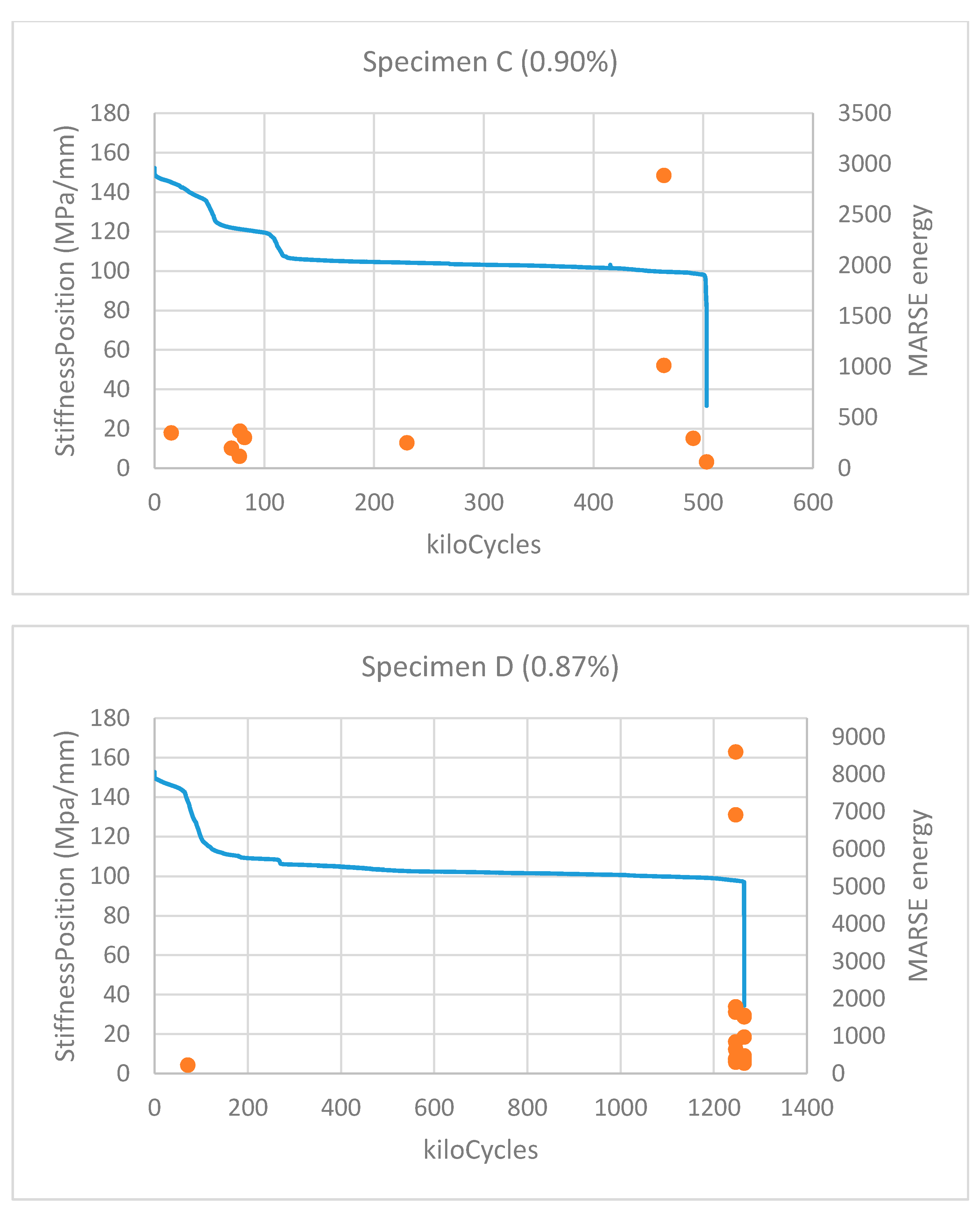

| Specimen Series, Ordered by Descending JR Value | JR (N/mm) | Total Number of AE Hits during Test | Number of AE Hits Violating | |||
|---|---|---|---|---|---|---|
| One Parameter | Two Parameters | Three Parameters | Four Parameters | |||
| Specimen A | 1.40 | 19,997 | 0 | 0 | 0 | 0 |
| Specimen D | 1.35 | 23,320 | 0 | 0 | 0 | 0 |
| Specimen C | 1.20 | 16,869 | 1 | 0 | 0 | 0 |
| Specimen B | 1.15 | 14,258 | 3 | 2 | 0 | 0 |
| Specimen F | 0.90 | 19,920 | 5 | 4 | 2 | 2 |
| Specimen E | 0.80 | 29,600 | 23 | 21 | 14 | 5 |
| Specimen | Peak Strain (%) | Cycles to Failure |
|---|---|---|
| A | 1.00 | 140,206 |
| B | 0.95 | 904,807 |
| C | 0.90 | 503,096 |
| D | 0.87 | 1,265,287 |
Publisher’s Note: MDPI stays neutral with regard to jurisdictional claims in published maps and institutional affiliations. |
© 2020 by the authors. Licensee MDPI, Basel, Switzerland. This article is an open access article distributed under the terms and conditions of the Creative Commons Attribution (CC BY) license (http://creativecommons.org/licenses/by/4.0/).
Share and Cite
McGugan, M.; Mishnaevsky, L., Jr. Damage Mechanism Based Approach to the Structural Health Monitoring of Wind Turbine Blades. Coatings 2020, 10, 1223. https://doi.org/10.3390/coatings10121223
McGugan M, Mishnaevsky L Jr. Damage Mechanism Based Approach to the Structural Health Monitoring of Wind Turbine Blades. Coatings. 2020; 10(12):1223. https://doi.org/10.3390/coatings10121223
Chicago/Turabian StyleMcGugan, Malcolm, and Leon Mishnaevsky, Jr. 2020. "Damage Mechanism Based Approach to the Structural Health Monitoring of Wind Turbine Blades" Coatings 10, no. 12: 1223. https://doi.org/10.3390/coatings10121223
APA StyleMcGugan, M., & Mishnaevsky, L., Jr. (2020). Damage Mechanism Based Approach to the Structural Health Monitoring of Wind Turbine Blades. Coatings, 10(12), 1223. https://doi.org/10.3390/coatings10121223






